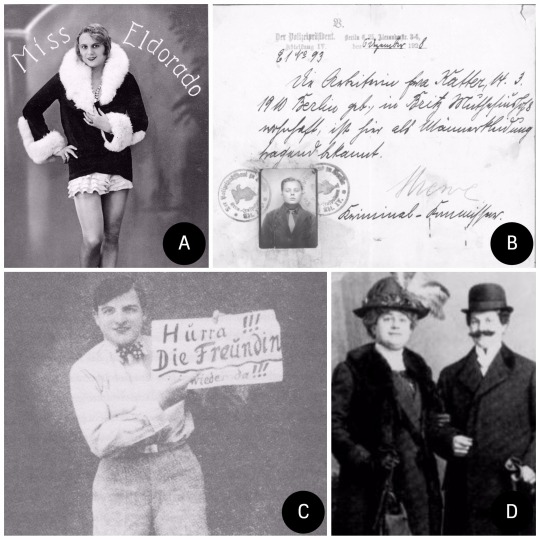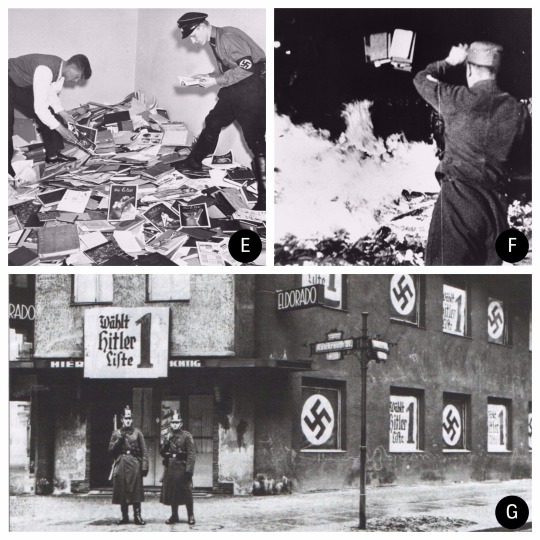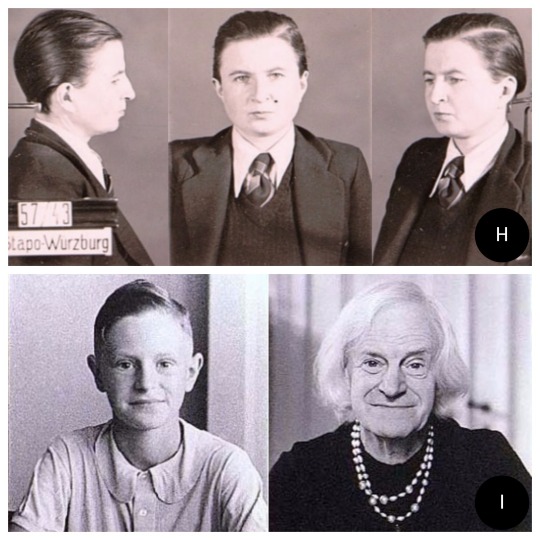by Andy B.
While it’s becoming common knowledge that gay people were persecuted during the Holocaust, “historians have only recently begun to examine [the treatment of transgender people] under the Nazi state” (Marhoefer 1178). This post investigates what life may have been like for individuals who we would today call trans—including gender nonconforming folks, cross-dressers, and “transvestites”—in Germany before and during the Third Reich.
I- Transgender Life in Germany before the Third Reich

A: “Hansi Sturm was the winner of the Miss Eldorado transvestite pageant in 1926” SOURCE B: “This ‘transvestite certificate’ reads, ‘the worker Käthe T., born in Berlin in 1910, resident at 8 Muthesiushof, Britz, is locally known to wear men’s clothing,’” 1928 SOURCE C: Picture of Berlin entertainer Lotte Hahm, circa 1929 SOURCE D: “Happily married transvestite couple[;] ’she’ is a man, ‘he’ is a woman,” 1930 SOURCE
In the years before Hilter’s rise to power, Germany was home to a few social movements dedicated to supporting trans people. Magnus Hirschfeld, a German sexologist, coined the term “transvestite” in 1910 (Stryker 38), which was then used to describe “people whose authentic gender did not match the gender they were assigned at birth, as well as […] people who understood themselves to be cross-dressers or gender nonconformists” (Marhoefer 1169). Hirschfeld went on to found the Institute of Sex Research (Institut für Sexualwissenschaft) in Berlin in 1919, which sought to help trans people in various ways, such as giving them access to “cross-dressing permits” [B] and medical care. While still stigmatized, transvestites, as they were known then, began to live more openly: Lotte Hahm, an entertainer “who identified […] as both a lesbian and a transvestite,” is one example [C] (Marhoefer 1175); another example is the Eldorado nightclub in Berlin, “widely known to be a regular venue for transvestites” [A] (Cabaret Berlin).
II- Transgender Life in Nazi Germany

E: “German students and Nazi SA plunder the library of Dr. Magnus Hirschfeld, Director of the Institute for Sexual Research in Berlin. The materials were loaded onto trucks and carted away for burning. The public library of the Institute comprised approximately 10,000 mostly rare German and foreign books on the topics of sex and gender,” 1933 SOURCE F: “A member of the SA throws confiscated books into the bonfire during the public burning of "un-German” books on the Opernplatz in Berlin,” 1933 SOURCE G: The Eldorado, turned into local headquarters for the SA, circa 1932 SOURCE
Those advances were cut short with Hitler’s rise to power in the 1930s. In fact, “Hitler personally denounced Hirschfeld, who was a socialist as well as a homosexual, as ‘the most dangerous Jew in Germany,’” forcing Hirschfeld to flee the country. In 1933, “fascist vigilantes ransacked and destroyed Hirschfeld’s Institute in Berlin,” publicly burning all of their research [E, F] (Stryker 40). Around the same time, the Eldorado had to close its doors, and the SA “turned the Eldorado into their new local headquarters” [G] (Cabaret Berlin).
For the Nazis, trans people were seen as “endanger[ing] orderly life and the wellbeing of society;” one Nazi-era study claimed that “their asocial dispositions, which are often paired with criminal activity, justify draconian measures on the part of the state” (Marhoefer 1182). Transfeminine folks, especially, were in danger of persecution, because they were assumed to be gay men. For the German authorities, “‘transvestite’ and ‘homosexual’ functioned as adequate catch-all and overlapping terms” (Caplan 173). Gay men were targeted for persecution because they were viewed as “carriers of a ‘contagion’ that weakened society and did not contribute to the desired growth of the ‘Aryan’ population.” It is estimated that “between 5,000 and 15,000 [gay men] were interned in concentration camps,” and an unknown number of them perished (United States Holocaust Memorial Museum). Since the Nazis conflated transvestitism and homosexuality, it is very likely some of the individuals marked as gay were trans.
Lesbians and transmasculine folks were treated with ambivalence under the Nazi regime; they were not explicitly persecuted the way gay men and transfeminine folks were, but were still at increased risk of violence during the Third Reich. Many “lesbians and female-to-male transvestites were harassed, terrorized, and subjected to violence by state and party officials and hostile neighbors at least in part on account of their gender or sexuality” (Marhoefer 1169). For example, “Ilse Totzk […] was an ‘Aryan’ who risked her life trying to help a German Jew” and was sent to a concentration camp after being arrested by the Gestapo. As “a self-consciously masculine woman,” Totzk “may have considered herself a lesbian and/or a transvestite” [H] (1171-72). She was treated with extreme scrutiny by the Gestapo, probably at least in part because she was gender nonconforming; in addition to being seen as asocial and contagious, transvestites were sometimes thought to be spies and accused of using cross-dressing as a disguise (1181).
Another example of a trans person alive during the Third Reich is Charlotte von Mahlsdorf, born in 1928 [I]. Assigned male at birth, Charlotte felt female from a young age; she suffered years of abuse from her father, a Nazi party leader, until she killed him in self-defense in 1944. She was released from juvenile prison after the war, and continued to live as a woman until her death in 2002 (Frazier).

H: “Photographs of Ilse Totzke taken by the Gestapo after her 1943 attempt to flee Germany,” 1943 from Marhoefer’s “Lesbianism, Transvestitism, and the Nazi State,” p. 1175 I: Charlotte von Mahlsdorf as a child and as adult, dates unknown SOURCE
The treatment of transgender people during the Third Reich is something we still know little about. Historical research on the topic suggests Nazi Germany did not have specific guidelines for dealing with transvestites, at times conflating them with gay people, at others suspecting them to be spies. “Was this because the numbers were too small and the anomalies too marginal to generate any public danger or any clear standard of decision?” As Caplan writes, “historians must sometimes be content with this kind of unsatisfactory conclusion” (176). Conversely, it is very possible that the topic has not been researched enough yet, especially since transgender studies is a fairly new field. Hopefully, future research will uncover more about the realities of living as a trans person in Nazi Germany, so that we can better understand what these people must have gone through.
Sources:
- Caplan, Jane. “The Administration of Gender Identity in Nazi Germany.” History Workshop Journal : HWJ, vol. 72, 2011, pp. 171–80.
- “Eldorado.” Cabaret Berlin, 2010, www.cabaret-berlin.com/?p=11.
- Frazier, Krystle. “Charlotte Von Mahlsdorf.” Women in European History, 2010, womenineuropeanhistory.org/index.php?title=Charlotte_von_Mahlsdorf.
- Marhoefer, Laurie. “Lesbianism, Transvestitism, and the Nazi State: A Microhistory of a Gestapo Investigation, 1939–1943.” The American Historical Review, vol. 121, no. 4, 2016, pp. 1167–1195.
- Stryker, Susan. “A Hundred Years of Transgender History.” Transgender History, Seal Press, 2008, pp. 31–57.
- United States Holocaust Memorial Museum. “Persecution of Homosexuals in the Third Reich.” Holocaust Encyclopedia. www.ushmm.org/wlc/en/article.php?ModuleId=10005261#.





